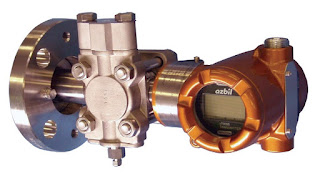 |
| Flange mount differential pressure transmitter Courtesy Azbil North America |
Deriving tank liquid level can be accomplished utilizing a number of technologies, classed as direct or inferred. Direct level readings indicate level by interacting with the interface of the liquid surface and the unfilled area of the tank. A simple example of this would be a float, the position of which is read on a scale or transmitted to a controller. Inferential measurements are derived by directly measuring a condition which is affected in a predictable manner by the tank liquid level.
Differential pressure is an inferential methodology for determining liquid level. A differential pressure transmitter measures the total pressure of the fluid column and subtracts the pressure exerted on the surface of the liquid, delivering a signal indicating the net pressure exerted by the liquid column in the vessel. This value can be used to calculate the height of the liquid column, weight of the fluid, percentage of tank fill, or other useful values. The differential pressure method of liquid level measurement has some key features:
- Cost effective
- Limited moving parts in a complete installation, generally consisting of isolation valves for transmitter servicing
- Best applied to clean liquids with known uniform density
- Provides good accuracy over a wide operating range
- Easily mounted or retrofitted to vessel surfaces
- Low maintenance requirements
- Specifically designed seals can be utilized to provide hygienic vessel connections, or device protection from high temperature or corrosive process media
Like any measurement technology, the differential pressure method of liquid level measurement provides the best results when properly installed and maintained. There are numerous installation configurations and options to fulfill a wide variety of applications. A product application specialist can help you specify the best arrangement for your application.